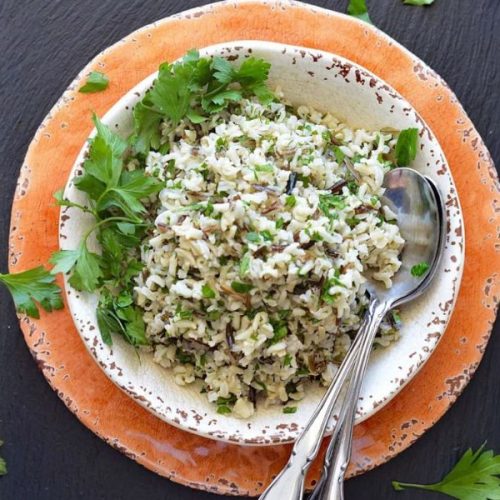This Herbed Wild Rice Pilaf is a flavorful and wholesome side dish, combining the nutty texture of wild rice with aromatic herbs and tender brown rice.
Packed with fiber, plant-based protein, and essential nutrients, this pilaf supports digestive health and keeps you satisfied longer.
Vegan margarine and vegetable broth provide a low-saturated-fat base while enhancing richness and depth of flavor.
Fresh thyme and parsley not only brighten the dish visually but add antioxidants and natural flavor without extra calories or sodium.
Quick to prepare and forgiving in the cooking process, this pilaf is a versatile choice for everyday meals, weeknight dinners, or meal-prep batches.

Its light yet hearty profile pairs beautifully with roasted vegetables, vegan mains, or plant-based protein dishes, making it a staple for healthy, flavorful cooking.
Must-Have Tools for Perfect Results
Large Stock Pot
Ideal for even cooking of rice and herbs. Also perfect for soups, stews, and one-pot meals.
Chef’s Knife
Essential for finely chopping onions, garlic, and parsley quickly and safely. A versatile tool for all kitchen prep.
Measuring Cups & Spoons
Ensures precise amounts of rice, broth, and herbs for consistent results every time. Vital for baking and cooking accuracy.
Wooden Spoon
Gently stirs ingredients without scratching cookware, ensuring even flavor distribution. Great for sautéing, mixing, and folding.
Fork
Perfect for fluffing cooked rice to separate grains and incorporate herbs evenly. Also useful for salads, scrambled eggs, or tender vegetables.

Easy Herbed Wild Rice Pilaf
Equipment
- Large Stock Pot
- 1 Chef’s Knife
- Measuring Cups & Spoons
- 1 Wooden spoon
- 1 Fork
Ingredients
- 1 1/2 tbsp Vegan Margarine
- 1 1/2 cups Onion finely chopped
- 3 cloves Garlic minced
- 3/4 cup Wild Rice uncooked
- 1/2 cup Long Grain Brown Rice uncooked
- 3/4 tbsp Thyme chopped
- 2 cups Vegetable Broth
- 1/2 tsp Salt
- 1/4 tsp Black Pepper
- 1 Bay Leaf
- 1/4 cup Parsley chopped
Instructions
- Melt Margarine and Sauté Onions: In a large stock pot, melt the vegan margarine over medium-low heat until fully liquefied. Add the finely chopped onions and cook for 8–10 minutes, stirring occasionally, until the onions turn translucent and soft. This gentle cooking process releases the onions’ natural sweetness and forms a flavorful base for the pilaf.
- Add Garlic and Cook Briefly: Add the minced garlic to the onions and sauté for 1–2 minutes, stirring frequently to prevent burning. The garlic should become fragrant without browning, as overcooked garlic can taste bitter and overwhelm the delicate rice flavors.
- Toast the Rice with Herbs: Increase the heat to medium-high and stir in the wild rice, brown rice, and chopped thyme. Cook for about 1 minute while stirring constantly to lightly toast the grains, which enhances their nutty flavor and helps them maintain a firm, separate texture during simmering.
- Incorporate Broth and Seasonings: Pour in the vegetable broth, then add salt, black pepper, and the bay leaf. Stir briefly, then bring the mixture to a boil over medium-high heat. Boiling ensures that the rice begins absorbing the liquid evenly, setting the stage for tender, fully cooked grains.
- Simmer Covered and Undisturbed: Reduce the heat to low and cover the pot with a tight-fitting lid. Allow the rice to simmer gently for 1 hour, without stirring, until both the wild and brown rice are tender. The low, steady heat ensures even cooking and prevents the rice from becoming mushy.
- Finish with Parsley and Fluff: Remove the pot from heat and let the rice stand covered for 10 minutes. Discard the bay leaf, then use a fork to fluff the rice, gently incorporating the chopped parsley. This final step keeps the grains separate while adding a fresh, herbaceous flavor, resulting in a perfectly light and aromatic pilaf ready to serve.
Notes
- Use a combination of wild rice and brown rice for a nutty flavor and chewy texture.
- Do not stir the rice while simmering, as it can become mushy.
- Adjust salt and pepper to taste after cooking for balanced flavor.
- Fresh herbs like parsley and thyme add brightness and antioxidants; dried herbs can be used if needed.
- The pilaf can be made ahead and reheated gently before serving.
- For added richness, a small splash of olive oil or vegan butter can be stirred in before serving.
Chef’s Secrets For Perfect Pilaf
Achieving a light, fluffy pilaf begins with proper rice-to-liquid ratio and gentle heat. Toasting the rice with herbs before adding broth enhances its nutty flavor.
Avoid stirring during the simmering process to maintain separate grains and a tender texture.
Using fresh herbs like thyme and parsley at the end adds vibrant color and freshness without overwhelming the subtle rice flavors.
Simmering slowly allows the rice to fully absorb the vegetable broth, creating a rich, savory taste that makes this pilaf a standout side dish.
Serving Suggestions And Flavor Pairings
This Herbed Wild Rice Pilaf pairs beautifully with roasted or grilled vegetables, vegan mains, or plant-based proteins such as tofu or tempeh.
It also complements soups, stews, or a hearty bean chili.
For festive occasions, garnish with toasted nuts or seeds for extra texture and flavor.
A drizzle of olive oil or a squeeze of lemon before serving can further elevate the aroma and brightness of the dish.
This versatile pilaf works as a side dish for both casual meals and more elegant dinner spreads.
Storage Tips For Fresh Pilaf
Store leftover pilaf in an airtight container in the refrigerator for up to 5 days.
Reheat gently on the stovetop over low heat or in the microwave, adding a splash of vegetable broth to maintain moisture.
For longer storage, freeze the pilaf in a freezer-safe container for up to 3 months.
Thaw overnight in the refrigerator before reheating. Avoid reheating multiple times, as this can make the rice dry and compromise its texture.
Frequently Asked Questions
1. Can I make this pilaf gluten-free?
Yes, this recipe is naturally gluten-free as it contains only rice and herbs. Ensure any added broth or seasonings are also gluten-free.
2. Can I use only one type of rice?
You can, but combining wild and brown rice gives a more interesting texture and flavor. Using only one type may produce a softer, less complex dish.
3. Can I make this ahead of time?
Absolutely! Prepare the pilaf up to a day in advance and store in the refrigerator. Reheat gently to preserve texture and flavor.
4. Can I add vegetables or nuts?
Yes, ingredients like sautéed mushrooms, carrots, peas, or toasted almonds pair beautifully with the pilaf, adding extra flavor, texture, and nutrition.
5. How do I prevent rice from sticking?
Use a nonstick or heavy-bottomed pot and avoid stirring during cooking. Gently fluff with a fork after standing to separate the grains.
This recipe has been adapted and simplified from the original version by theveglife. We’ve refined the steps for a smoother cooking experience and added helpful notes, nutrition insights, and essential kitchen tools to make it even easier for home cooks.

